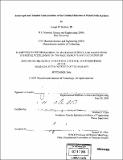Anisotropic and tunable characteristics of the colloidal behavior of metal oxide surfaces
Author(s)
Bullard, Joseph Warren, 1978-
DownloadFull printable version (25.79Mb)
Other Contributors
Massachusetts Institute of Technology. Dept. of Materials Science and Engineering.
Advisor
Michael J Cima.
Terms of use
Metadata
Show full item recordAbstract
The electroosmotic behavior of the rutile polymorph of titanium dioxide was explored as a function of crystallographic orientation. Atomic force microscopy (AFM) was employed to make high-resolution force spectroscopy measurements between a silica sphere attached to a traditional, contact-mode AFM cantilever and TiO2 (110), (100), and (001) surfaces in aqueous solutions. Measurements were taken in a variety of solution conditions across a broad range of pH values, and the resultant force-distance curves were used to deduce relative behaviors of each orientation of rutile, with particular interest in changes of the isoelectric point (iep). Differences in iep as a function of orientation are explained in terms of differences in both the coordination number and density of (Lewis) acidic and basic sites on the surface. The results were supported by angle-resolved X-ray photoelectron spectroscopy (XPS) measurements of a nominal monolayer of palladium metal deposited on each of the three orientations studied. The palladium monolayer served as a means of probing the relative electron affinities of the three surfaces studied, which was exhibited in shifts of the palladium XPS peak that corresponded to differences in binding energy as a function of substrate orientation. (cont.) The correlation between rutile orientation and shift in palladium binding energy corresponded directly to the relationship between isoelectric point and orientation, with the surface of lowest isoelectric point exhibiting the highest Pd binding energy. Force spectroscopy was also used to investigate the changes in the electroosmotic behavior of rutile surfaces induced by exposure to ultraviolet irradiation (UV). Force-distance measurements using a silica sphere in aqueous potassium chloride solutions were performed on surfaces exposed to UV, and compared with data taken on identically oriented surfaces stored in darkness. Changes in the characteristics of both the extension and retraction components of the force measurements were observed. Differences in the former suggest changes in the double layer characteristics of the rutile surfaces, whereas differences in the latter denote changes in the adhesion forces between the probing silica sphere and the surface.
Description
Thesis (Ph. D.)--Massachusetts Institute of Technology, Dept. of Materials Science and Engineering, 2006. Includes bibliographical references.
Date issued
2006Department
Massachusetts Institute of Technology. Department of Materials Science and EngineeringPublisher
Massachusetts Institute of Technology
Keywords
Materials Science and Engineering.